Article Analysis GLOBALIZATION AND THE EVOLUTION OF THE SUPP
Article Analysis
GLOBALIZATION AND THE EVOLUTION OF THE SUPPLY CHAIN: WHO GAINS AND WHO LOSES?
I neeed help with writing an article analysis on this topic it has to be aleast 4 -5 pages and can you type it thanks. You can use any article that is realted to this topic thanks.
Solution
A developing number of firms separate their creation procedure
into different stages spread crosswise over various nations or regions.1 Particularly,
the firm arranges and performs discrete exercises in particular areas, which
out and out frame an inventory network startingat the origination of the item and
endingat its conveyance. This spatial fracture of generation goes for tak-
ing preferred standpoint of contrasts in innovations, factor blessings, or factor
costs crosswise over spots (Feenstra, 1998). It is viewed as one of the principle ingre-
dients of the procedure of financial globalization and, in that capacity, has produced
unforgiving verbal confrontations in many nations. Specifically, some arrangement producers and the
general press in industrialized nations tend to see it as the principle compel
drivingthe growingwage imbalance amongst gifted and untalented laborers.
For different gatherings and nongovernmental associations, the progression of
exchange and capital streams, which run as an inseparable unit with discontinuity, would
likewise be hindering to undeveloped nations, by fosteringmore universal
monetary disparity. Our motivation is to demonstrate that globalization require not have
such adverse ramifications for low-salary individuals and nations.
The most normally watched design correspondingto worldwide frag-
mentation is with the end goal that organizations re-find their generation exercises in low-wage
locales, while keeping their key capacities (e.g. administration, Research and development,
marketingand back) gathered in a couple of wealthy urban locales where
the high-talented laborers they require are accessible. For instance, though the
metropolitan regions of Tokyo and Osaka hold countless
ters, business-to-business benefit firms and research labs, a developing number
of Japanese manufacturingplants move to China where work is significantly less expensive
(the Chinese/Japanese wage proportion fluctuates from 1/10 to 1/20). This is espe-
cially all around outlined by the hardware business, which is the quickest developing
manufacturingsector in Japan since the mid-1970s. This industry is domi-
nated by nine firms (Hitachi, Matsushita Electric, Toshiba, NEC, Mitsubishi
Electric, Fujitsu, Sony, Sanyo Electric, and Sharp), of which add up to deals in
1990 were just about 200 billion dollars. Fujita and Ishii (1998) report that,
from 1975 to 1994, the quantity of abroad plants situated in East Asia has
expanded from 40 to 143. By differentiate, the quantity of Research and development offices has in-
wrinkled from 24 to 115 in Japan and from 0 to 6 in East Asia
late time of 1991-1993, the expansion in the quantity of plants situated in
East Asia has blasted to 29.
Unmistakably, there is a requirement for a superior understandingof the conceivable eco-
nomic outcomes of the procedure of global fracture. Inside
the neoclassical system of exchange hypothesis, its effect on yield, compensation and
welfare has been considered by assumingthat fracture adds up to a few
type of innovative advance. As anyone might expect, comes about are regularly ambigu-
ous in light of the fact that they rely upon whether seaward outsourcingtakes put in a
work concentrated or in a capital-escalated area (Jones and Kierzkowski, 2001).
In any case, it has likewise been contended that global fracture moves up
the creation probability outskirts of the national economy, in this manner recommend
ingthat it is dependably welfare-enhancing(Arndt, 1997). Whenever fracture
changes costs, Deardoff (2001) qualifies such an announcement by appearing, to the point that
the development of a store network can influence antagonistically one nation by turning
its terms of exchange against it. Besides, notwithstanding when a nation picks up from
discontinuity, some consider proprietors this nation may lose.2
In this paper, we are occupied with studyingcross-outskirt discontinuity
in an alternate setting, thus for no less than two reasons. To begin with, we accept
that blemished rivalry suits better the conduct of firms occupied with
dividing their creation than perfects rivalry. Second, we
take into account work dualism on the grounds that the presence of both talented and untalented
work is urgent for universal fracture to emerge. To accomplish our objective,
we along these lines utilize a general balance model of monopolistic rivalry `a
la Dixit-Stiglitz that joins the accompanying fixings. Each firm has
two units, a headquarter and a solitary plant. Central station utilize gifted work
while plants utilize headquarter benefits together with incompetent work. Each
firm is allowed to decentralize its creation abroad by choosingfor its plant a
area a long way from its headquarter. Other than its more noteworthy authenticity, this displaying
procedure enables us to coordinate different thoughts inside a typical structure,
which can be tackled logically.
In the writing, the common decrease in transportation and exchange costs
has been considered as a noteworthy component of the procedure of globalization. We
likewise need to pressure the way that the advancement of new data and
correspondence advancements is another significant power that ought to be accounted
for keeping in mind the end goal to better comprehend the advancement of the geology of present day
economies. In light of this, two sorts of spatial expenses are taken into
account in our model, to be specific correspondence expenses and exchange costs. Low
exchange costs permit firms producingoverseas to offer their yield on their home
advertise at a low cost. Similarly vital, yet maybe less perceived, is
the way that coordinatingactivities inside the firm is all the more expensive when
headquarter specialists and plant laborers are physically isolated. Be that as it may,
bring down correspondence costs make such a coordination less demanding and, along these lines,
encourages the procedure of fragmentation.3 How does the spatial division of
work change when correspondence and exchange costs progress toward becoming lower, and what
are the correspondingimplications for the different gatherings of specialists, are
absolutely the subjects we need to think about in this paper.
Administration offices are built up in expansive urban agglomerations be-
cause huge numbers of the capacities in which they are included require individual
correspondences amongskilled laborers. These contacts encourage the trans-
mission of data with respect to the advancement of new items (Duranton
what\'s more, Puga, 2001), while enabling laborers of various firms to manufacture the trust
required to compose fragmented contracts (Leamer and Storper, 2001). Head-
quarters specialists additionally advantage from the accessibility of separated nearby
benefit providers and from the vicinity of different home office and power
focuses, for example, governments, exchange affiliations and universal organizations
(Davis and Henderson, 2003). Despite the fact that those different procedures might be
depicted at the microeconomic level (Fujita and Thisse, 2002; Duranton and
Puga, 2004), for our motivation it is helpful to work with a diminished shape
for example, the one utilized by Henderson (1988), in which all microeconomic in-
teractions amongheadquarters\' specialists are subsumed by methods for a basic
Marshallian externality that says that the gainful productivity of headquar-
ters ascends with the quantity of firms having a place with a similar agglomeration.
For global discontinuity to emerge, the intra-firm coordination costs
must be adequately low with the goal that operatinga plant in a far off place isn\'t
too expensive, while exchange costs must abatement significantly to allow the
supply of substantial markets at low conveyance costs from removed areas. All together
to make low-wage zones more open and appealing for the setting of
their creation, firms in this manner require the advancement of new data
what\'s more, correspondence advances and a significant fall in exchange costs.
Strikingly, this is unequivocally what we have seen amid the most recent decades.
Previewingour fundamental outcomes, we examine in area 3 how plants are dis-
tributed between the two areas when all central command are set up in one
area. As said above, globalization has two primary aspects in that it goes hand
close by with bring down exchange hindrances as communicated through diminishing levies
also, transportation costs, from one viewpoint, and lower correspondence costs
amongst base camp and plants produced by the improvement of the new
data and correspondence innovations, on the other. In area 4, we
demonstrate that all plants are situated with their base camp when correspondence
costs are adequately high. For this situation, all organizations are national and built up
in the center area. When correspondence costs consistently diminish, the industry
advances toward a setup in which a few firms are multinational while
others are national. Note that a balance involvingfirms of various
types does not present itself since firms are from the earlier indistinguishable. It comes
about as the spatial division of work changes with the level of communi-
cation costs.4 In the long run, when these expenses have achieved an adequately low
level, the economy winds up with a deindustrialized center that holds as it were
firms\' key capacities.
A fall in exchange expenses may prompt decently differentiated examples of creation.
At the point when correspondence costs are high, decreasing exchange costs prompts a developing
agglomeration of plants inside the center, particularly as in the center fringe
display created by Krugman (1991). In any case, the agglomeration procedure is
here steady as opposed to showing a blast conduct. Things are completely
diverse when correspondence costs are low. For high exchange costs, most
plants are as yet situated inside the center locale. Be that as it may, once exchange costs
fall beneath some limit, the re-area process unfurls over a little range
of exchange cost esteems. This perception could clarify why the procedure of
deindustrialization of some created nations appears to be, to begin with, to be moderate and,
at that point, to continue rapidly, yieldinga space-economy altogether different from the
beginning one. In this manner, our model appears to help an (incomplete) deindustrialization
of the center locale, unless new exercises are created there.
At long last, our structure enables us to consider the effect of the lessening
in intrafirm
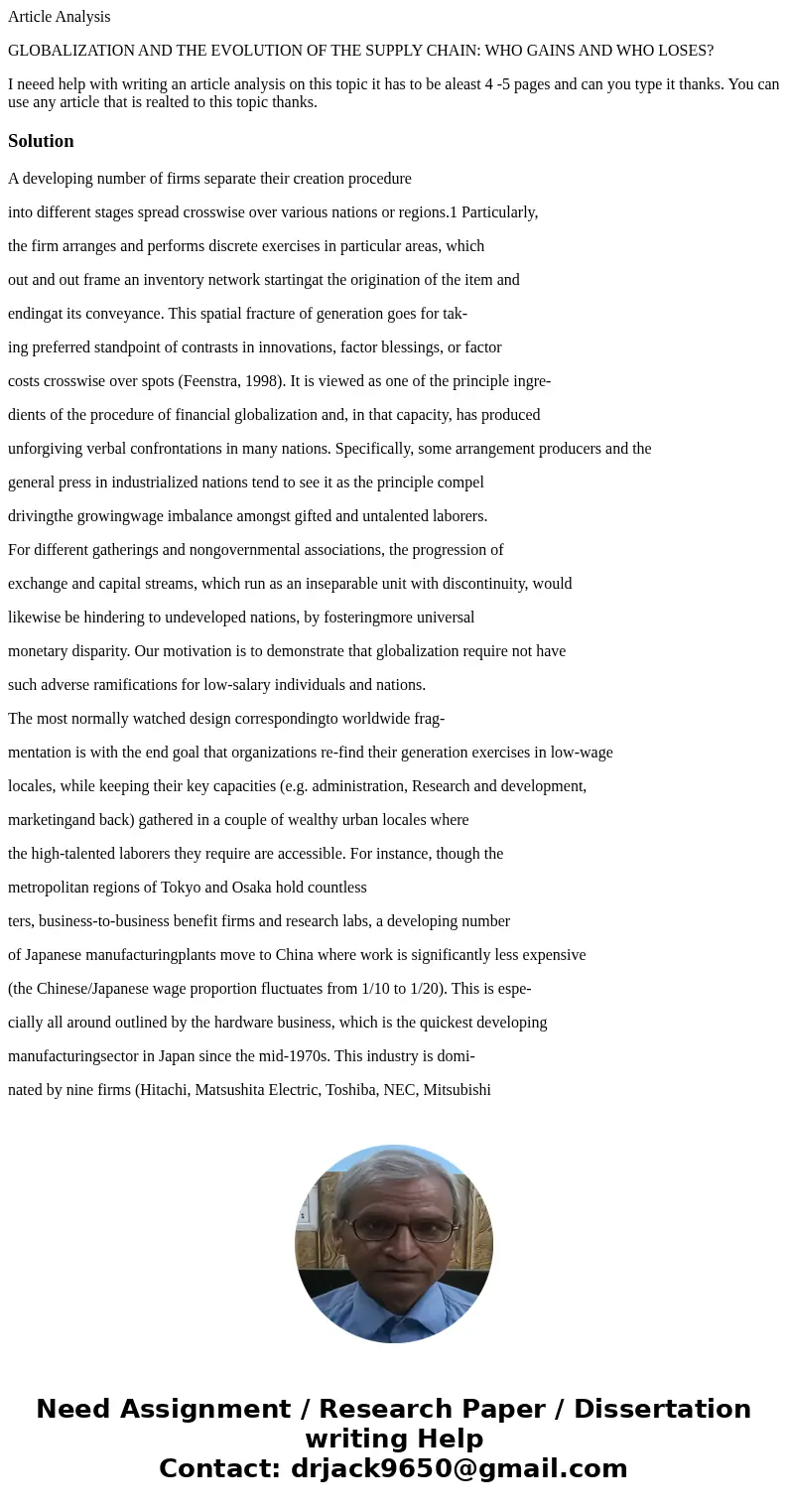
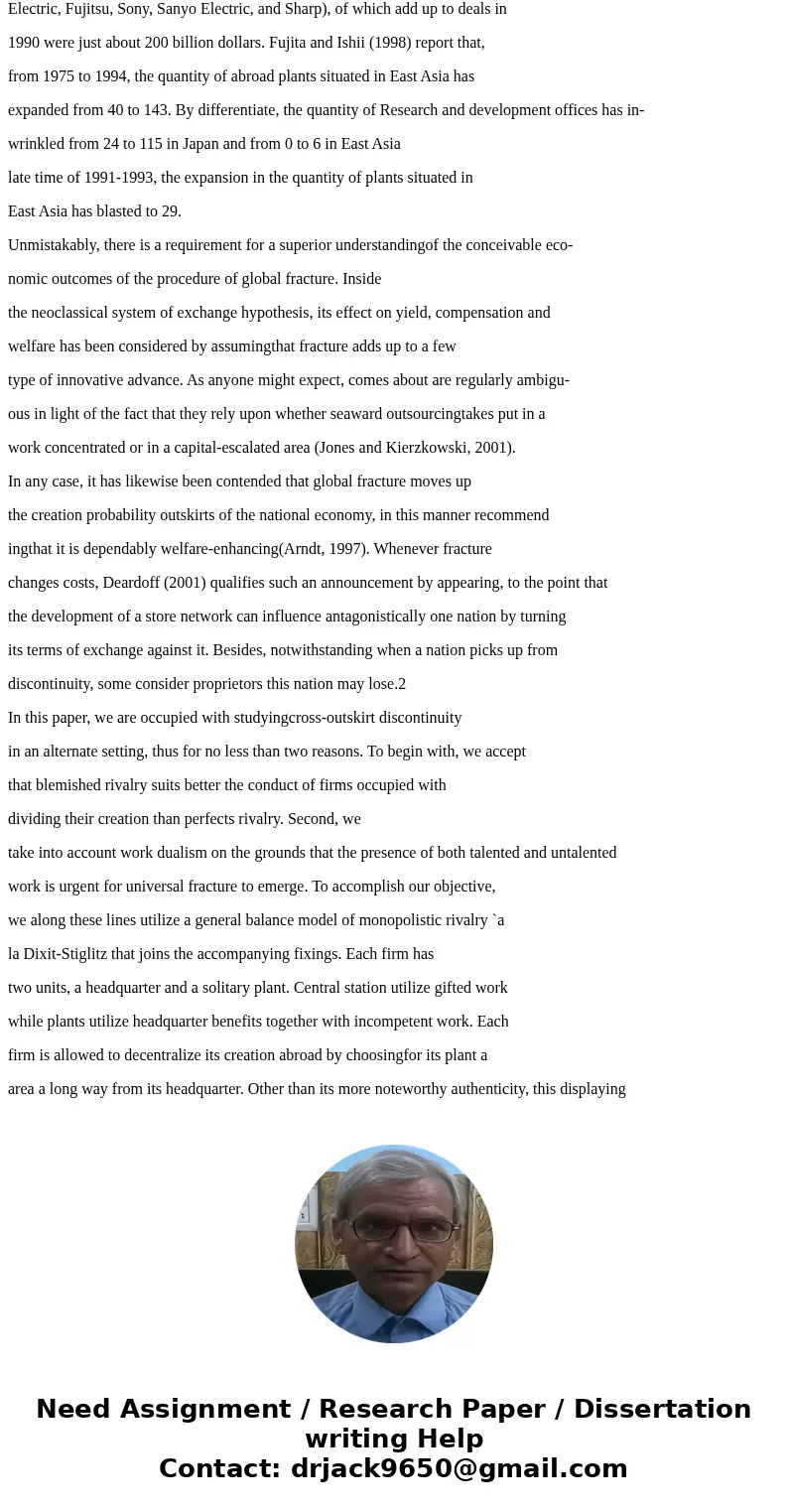
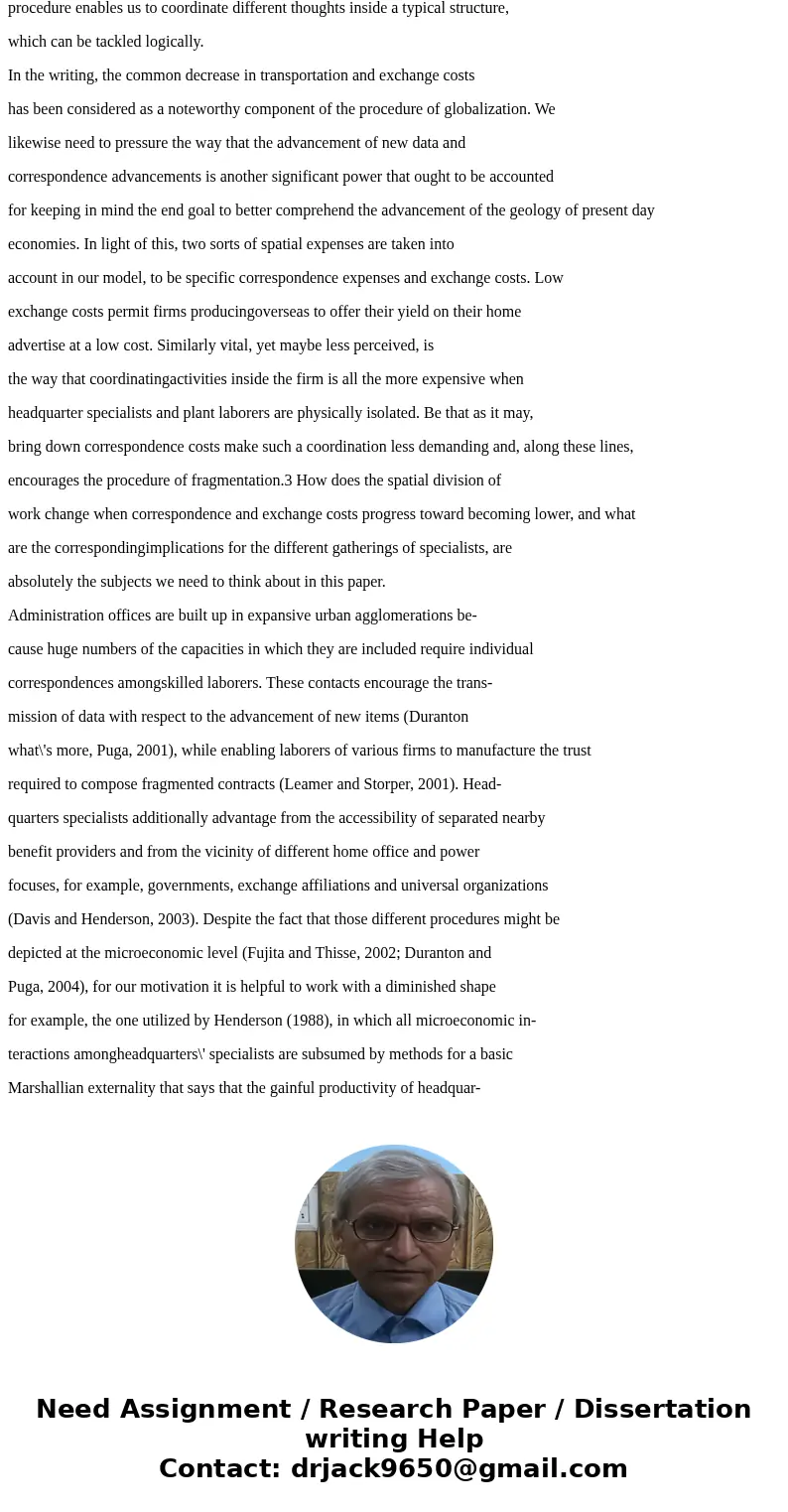
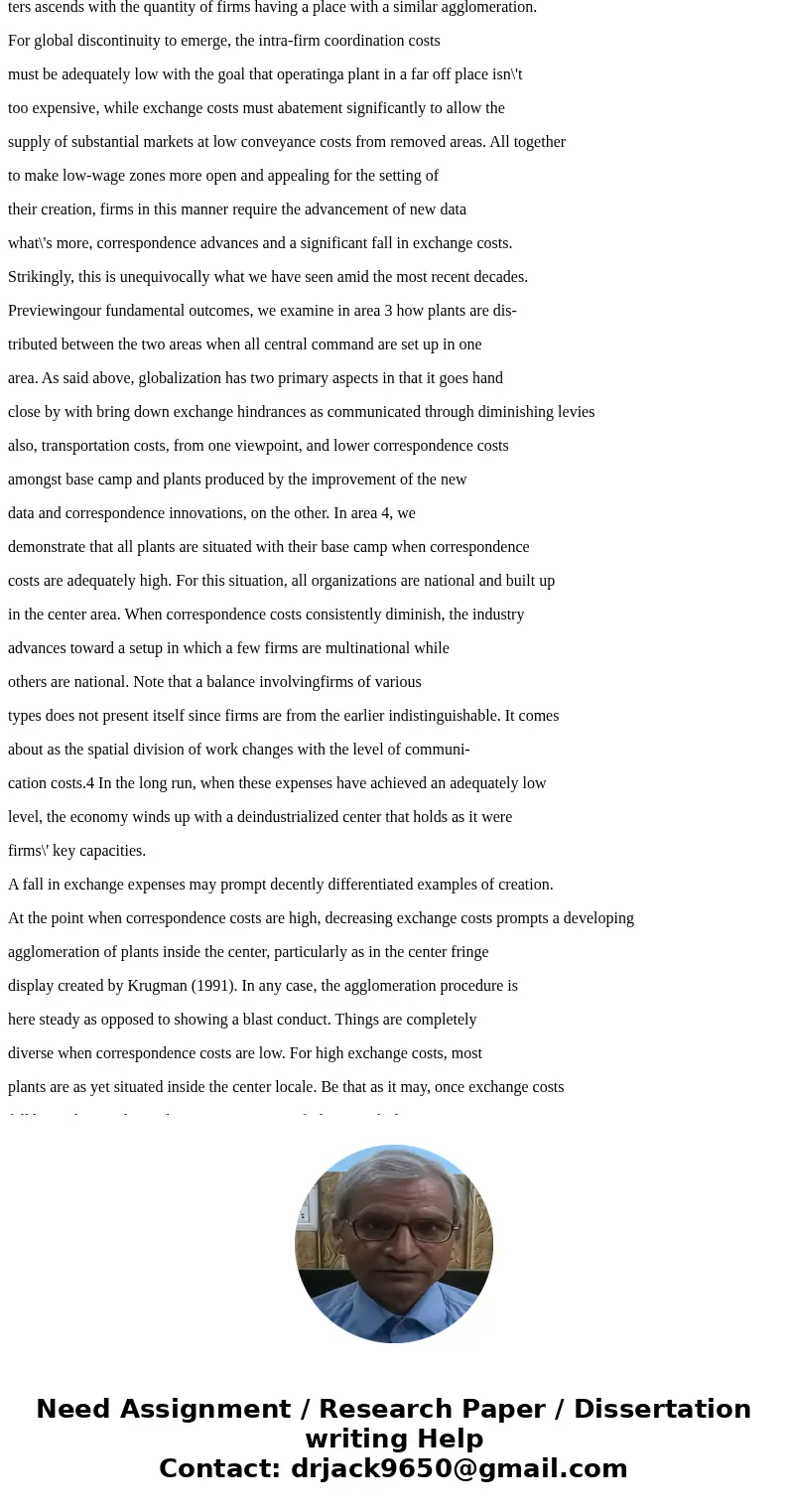
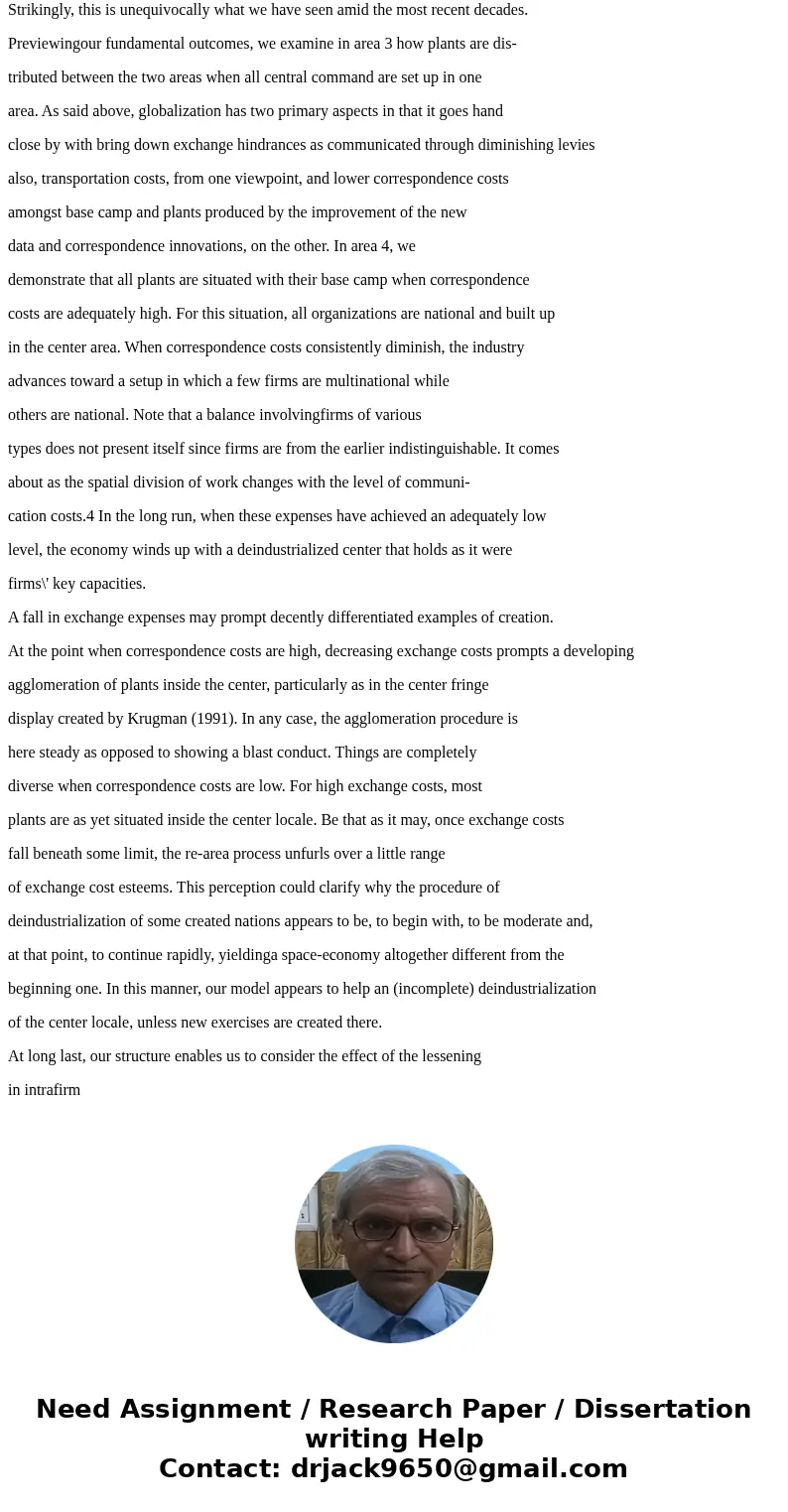
 Homework Sourse
Homework Sourse